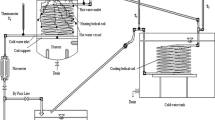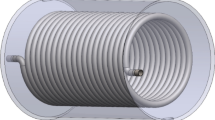Abstract
The study examined heat transfer of two dilute viscoelastic solutions in helical exchangers of circular cross-section. Ten helical coil heat exchangers with diameter ratios ranging from 4 to 50 were constructed. Results showed doubling the concentrations of polymer increased heat transfer performance by 12 %. The results were expressed in forms of some existing equations and were found to be in fair agreement to previous results.





Similar content being viewed by others
Abbreviations
- cp :
-
Specific heat
- d:
-
Tube diameter
- D:
-
Helix diameter of curvature
- Dn:
-
Dean number (Re(di/D)0.5)
- Gz:
-
Graetz number (mcp/kL)
- h:
-
Heat transfer coefficient
- hs :
-
Heat transfer coefficient, straight tube
- hc :
-
Heat transfer coefficient, curved tube
- k:
-
Thermal conductivity
- L:
-
Length
- m:
-
Mass
- Nu:
-
Nusselt number (hd/k)
- q:
-
Heat flux
- Q:
-
Volumetric flow rate (m3/s)
- Re:
-
Reynolds number (dvρ/μ)
- Pr:
-
Prandtl number (cpμ/k)
- T1 :
-
Inlet temp (°C)
- T2 :
-
Outlet temp (°C)
- Tw :
-
Average wall temp (°C)
- U:
-
Overall heat transfer coefficient
- v:
-
Velocity
- W:
-
Watt
- ρ:
-
Density
- μ:
-
Viscosity
- s:
-
Straight
- c:
-
Curved
- w:
-
Wall
- 1:
-
Inlet
- 2:
-
Outlet
References
Bergles AE (2011) Recent developments in enhanced heat transfer. Heat Mass Transf 47:1001–1008
Rogers GFC, Mayhew YR (1964) Heat transfer and pressure loss in helically helical tubes with turbulent flow. Int J Heat Mass Transf 7:1207–1216
Acharya N, Sen M, Chang HC (2001) Analysis of heat transfer enhancement in helical tube heat exchangers. Int J Heat Mass Transf 44:3189–3199
Cengiz Y, Yasar B, Dursun P (1995) Heat transfer and pressure drop in rotating helical pipes. Appl Energy 50(1):85–94
Kalb CE, Seader JD (1974) Fully developed viscous-flow heat transfer in curved circular tubes with uniform wall temperature. Am Inst Chem Eng J 20:340–346
Kubair V, Kuloor NR (1966) Heat transfer to Newtonian fluids in helical pipes in laminar flow. Int J Heat Mass Transf 9:63–75
Liu S, Masliyah JH (1994) Developing convective heat transfer in helical pipes with finite pitch. Int J Heat Fluid Flow 15(1):66–74
Naphon P, Wongwises S (2006) A review of flow and heat transfer characteristics in curved tubes. Renew Sustain Energy Rev 10:463–490
Patankar SV, Pratap VS, Spalding DB (1974) Prediction of laminar flow and heat transfer in helically helical pipes. J Fluid Mech 62:539–551
Prusa J, Yao LS (1982) Numerical solution for fully-developed flow in heated curved tubes. J Fluid Mech 123:503–522
Rindt CCM, Sillekens JJM, van Steenhoven AA (1999) The influence of the wall temperature on the development of heat transfer and secondary flow in a helical heat exchanger. Int Commun Heat Mass Transf 26:187–198
Seban RA, McLaughlin EF (1963) Heat transfer in tube coils with laminar and turbulent flow. Int J Heat Mass Transf 6:387–395
Tarbell JM, Samuels MR (1973) Momentum and heat transfer in helical coils. Chem Eng J 5:117–127
Shokouhmand H, Salimpour MR (2007) Entropy generation analysis of fully developed laminar forced convection in a helical tube with uniform wall temperature. Heat Mass Transf 44:213–220
Yang R, Chang CF (1994) Combined free and forced convection for developed flow in curved pipes with finite curvature ratio. Int J Heat Fluid Flow 15:470–476
Yang G, Dong F, Ebadian MA (1995) Laminar forced convection in a helicoidal pipe with finite pitch. Int J Heat Mass Transf 38:853–862
Zapryanov Z, Christov C, Toshev E (1980) Fully-developed laminar flow and heat transfer in curved tubes. Int J Heat Mass Transf 23:873–880
Mena B, Best G, Bautista P, Sanchez T (1978) Heat transfer in non-Newtonian flow through pipes. Rheol Acta 17(4):454–457
Hartnett JP, Kostic M (1985) Heat transfer to a viscoelastic fluid in laminar flow through a rectangular channel. Int J Heat Mass Transf 28(6):1147–1155
Yue P, Dooley J, Fenga JJ (2008) A general criterion for viscoelastic secondary flow in pipes of noncircular cross section. J Rheol 52(1):315–332
Siginer DA, Letelier MF (2010) Heat transfer asymptote in laminar flow of non-linear viscoelastic fluids in straight non-circular tubes. Int J Eng Sci 48(11):1544–1562
Agostini B, Watel B, Bontemps A, Thonon B (2002) Friction factor and heat transfer coefficient of R134a liquid flow in mini-channels. Appl Therm Eng 22(16):1821–1834
Ismail Z, Karim R (2012) Determination of optimum aspect ratio on laminar flow heat transfer of dilute viscoelastic solutions in flattened tube heat exchangers. J Heat Mass Transf 48(8):1319–1331
Tsang HY, James DF (1980) Reduction of secondary motion in curved tubes by polymer additives. J Rheol 24:589–601
Hsu C-F, Patankar SV (1982) Analysis of laminar non-Newtonian flow and heat transfer in curved tubes. Am Inst Chem Eng J 28(4):610–616
Inaba H, Aly WIA, Haruki N, Horibe A (2005) Flow and heat transfer characteristics of drag reducing surfactant solution in a helically coiled pipe. Heat Mass Transf 41(10):940–952
Ismail Z, Karim R (2012) Consolidation of heat transfer coefficients of viscoelastic simulated food solutions in helical exchangers. J Food Eng 108(1):122–127
Mori Y, Nakayama W (1967) Study on forced convection heat transfer in curved pipes. Int J Heat Mass Transf 10:681–694
Srinivasan PS, Nandapurkar SS, Holland FA (1968) Pressure drop and heat transfer in coils. Chem Eng (Lond) 218:113–119
Dravid AN, Smith KA, Merrill EW, Brain PLT (1971) Effect of secondary fluid motion on laminar flow heat transfer in helically helical tubes. Am Inst Chem Eng J 17:1114–1122
Ismail Z, Karim R (2012) Heat transfer of dilute polyacrylamide solutions in flattened tube exchangers. Exp Heat Transf. Accepted 27 Sept 2012
Ismail Z, Karim R (2012) Laminar flow heat transfer of dilute viscoelastic solutions in flattened tube heat exchangers. Appl Therm Eng 39:171–178
Author information
Authors and Affiliations
Corresponding authors
Appendix: Error estimates
Appendix: Error estimates
Density of water at 20 °C = 0.9982 g/l
Density of water at 40 °C = 0.9922 g/l
Error in assuming constant density = 0.006/0.9952 approximately = 0.5 %
Average flowrate = 10 ml/s
The gear pump was calibrated to read up to an accuracy of 0.2 ml/s
Average error in measuring volumetric flowrate = 0.2/10 approximately = 2 %
Error in obtaining mass flowrate = (0.5 + 2)% = 2.5 %
Error in assuming constant specific heat = 0.004/1.000 approximately = 0.5 %
Thermal conductivity at 285 K = 0.5818 w/(mK)
Thermal conductivity at 300 K = 0.6096 w/(mK)
Error in assuming constant thermal conductivity = 0.0278/0.5957 approximately = 5 %
Average length of exchanger tubes = 74.81 cm
Estimated error in length = 0.5/74.81 approximately = 0.5 %
Average error in Graetz Number (mcp/kL) = (2.5 + 0.5 + 5 + 0.5) % = 8.5 %
Average internal diameter is obtained by back-calculating from internal volumes and length of tubes. This gives an error of less than 2 %.
Velocity is proportional to Flowrate/(diameter)2
Error in velocity = (2.5 + 4) % = 6.5 %
Variations of viscosities and temperature for the solutions were experimentally determined.
Estimated error in reading from the calibration curves is about 1 %
Estimated error in Reynolds Number = (2 + 6.5 + 1) % = 9.5 %
Average diameter of curvature = 141.4 mm
Error in diameter of curvature = 0.5/141.4 approximately = 0.4 %
Error in Dean Number [Re(di/D)0.5] = [9.5 + (2 + 0.4)/2] % = 10.7 %
Overall error in Prandtl Number (cpμ/k) = (0.5 + 1 + 5) % = 6.5 %.
Error associated with using the Mori and Nakayama form = [(8.5/3) + (10.7/2)] % = 8.18 %
Error associated with using the Dravid form = [(10.7/2) + (6.5 × 0.175)] % = 6.5 %
Error associated with using the Cengiz form = [(10.7 × 0.864) + (6.5 × 0.4)] % = 11.8 %
Error associated with using the Kalb and Seader form = [(10.7*0.5) + (6.5*0.1)] % = 6 %.
Rights and permissions
About this article
Cite this article
Ismail, Z., Karim, R. Heat transfer of dilute viscoelastic solutions in helical exchangers. Heat Mass Transfer 49, 711–721 (2013). https://doi.org/10.1007/s00231-013-1113-3
Received:
Accepted:
Published:
Issue Date:
DOI: https://doi.org/10.1007/s00231-013-1113-3




